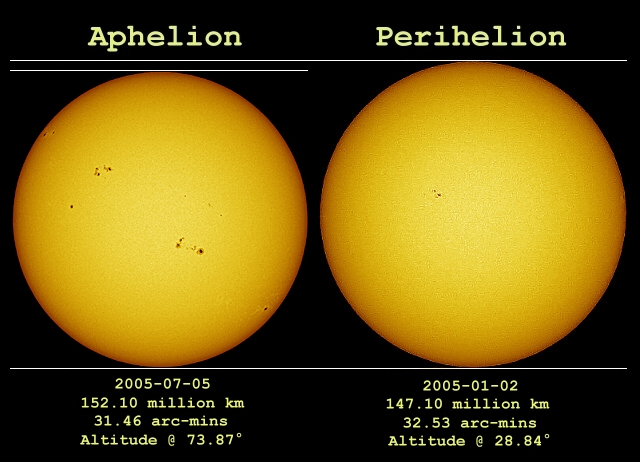 Criminy, I almost forgot: today, July 4th, at roughly 08:00 UT, the Earth was at aphelion.
Criminy, I almost forgot: today, July 4th, at roughly 08:00 UT, the Earth was at aphelion.Uh, what? I hear you ask. OK, brief astrolesson for ya, then back to the grill!
The Earth does not orbit the Sun in a perfect circle. The orbit is slightly elliptical. If you were to draw the Earth’s orbit on a piece of paper, you’d need a sharp eye to detect its non-circularity, but deviant it is. What this means in real terms is that the Earth ranges from about 148 to about 152 million kilometers from the Sun over the course of six months (which is how long it takes to get from one side of the orbit to the other, of course).
When the Earth is closest to the Sun it’s at perihelion, and when it’s farthest it’s called aphelion (I usually pronounce that app-helion, if you care, though I’ve heard others say aff-helion). So today we passed aphelion, and slowly but inexorably, over the next six months we’ll draw slightly closer to the Sun, and then the whole thing repeats.
That 4 million km difference sounds like a lot. But over the 150 million average radius of the orbit it’s only a slight difference by eye. The Sun will look about 3% larger at perihelion versus aphelion, and you’d never notice that, especially since the change is slow and takes six months. The amount of sunlight hitting the Earth does increase at perihelion, being about 5% greater than at aphelion. That’s quite a bit! But the effect isn’t as bad as you’d think. Why not?
For us northern hemisphere folks, we are farthest from the Sun in summer, and closest in winter, so that mitigates the temperature extreme. On average, winters are a bit warmer and summers a bit cooler. But wait! In the southern hemisphere, the seasons are reversed! So they should have extra hot summers and extra cold winters.
But they don’t. Why not? Because the southern hemisphere is mostly water. Go ahead, find a globe and take a look; it’s incredible how much of that half the Earth is water bound. Water absorbs and releases heat slowly, so all summer the oceans suck down that extra solar energy, and release it all winter. That helps balance out the temperature extremes.
Oh, one more thing: the Earth precesses, that is, the axis of rotation moves like a wobbling top. It takes a long time for the wobble to make one cycle, well over 20,000 years. But this changes the timing of the seasons compared to the orbit. In a few millennia, we’ll have perihelion at the same time as northern summer, and aphelion at northern winter. It’s hard to say what effect this will have on the environment, since it brings extra-hot summers and extra-cold winters. However, the last time this happened was around the same time the Sahara forest went away and was replaced by, well, guess.
But for today, don’t fret too much about wandering poles and aphelion… except to say, if you’re out sweltering in the Sun today celebrating the holiday in the U.S., you might want to take just a moment and be glad our orbit isn’t more elliptical, or that it isn’t 15,000 AD.
1 comment:
Fortunately I could read all your post (not to much on work) but I never think about it, I know that nothing it's perfect to me, and usually I had a lot question about many thinks that really doesn't matter the answer because probably we will never know, I saw the sun once on a eclipse and I could a imperfect circle I don't know why, but I'm sure it had a little imperfection.
----------------------------------------
Viagra Online
Post a Comment